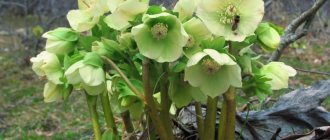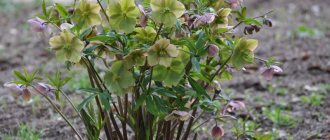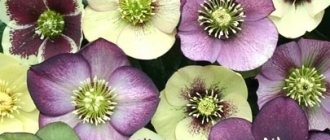Caucasian hellebore chopped 100 g with measuring spoon
Caucasian hellebore: plant features
Caucasian hellebore is a flowering plant of the Ranunculaceae family that grows in coniferous and beech forests and can often be found in gorges and on mountain slopes. The grass grows in Georgia and Kuban. The plant has characteristic flowers with light green petals and reddish veins on the petals. The grass got its name due to its resistance to low temperatures.
In our store you can purchase crushed herbs brought directly from the Caucasus, which is widely used in medicine. The online store presents natural health products that were collected in environmentally friendly places.
Beneficial properties of Caucasian hellebore
- Cleansing the body. The herb cleanses the circulatory and lymphatic system due to its mild laxative effect and, with regular use, removes toxins.
- Normalization of blood composition and prevention of changes in insulin.
- Hellebore reduces cravings for sweet and fatty foods, which prevents overeating and allows you to maintain normal weight.
- Elimination of salt deposits. This is especially true for the prevention of joint diseases, including gout.
- Normalization of the digestive system, normalization of stomach acidity.
- Normalization of the functioning of the genitourinary organs due to natural antimicrobial properties and diuretic effects.
- Expectorant properties and cleansing of the respiratory tract.
- Normalization of the psycho-emotional background, elimination of increased anxiety, depressed mood and sleep problems.
- Slowing down the division of malignant cells, which allows the use of hellebore for the prevention of cancer.
- Strengthening the immune system due to the active division of protective cells that respond to the occurrence of inflammatory processes.
Here are some pathologies that you can get rid of using this traditional medicine:
- Intestinal dysbiosis and chronic constipation. With regular use, the product normalizes stool.
- Hellebore can be used in the complex treatment of diabetes, as it prevents sudden spikes in insulin.
- Overweight and obesity caused by overeating. The plant's ability to reduce appetite has been proven.
- Gout and other diseases of the musculoskeletal system, which are characterized by salt deposition.
- Prostatitis, cystitis, inflammatory diseases of the genitourinary organs in men and women.
- Reproductive dysfunction, male and female infertility (can be used in complex treatment).
- Frequent viral and bacterial diseases caused by disruption of the immune system (hebores can be used as a preventive measure or during illness).
- Bronchitis, pneumonia, asthmatic diseases, pathologies of the respiratory system, which are characterized by the accumulation of sputum in the lungs.
- Suspicions of the development of cancer and hereditary predisposition (if tumors are diagnosed, you should first consult with a specialist).
- Gastritis, inflammation of the gallbladder.
Mode of application:
The course of treatment with hellebore is 12 months. In 4-6 months you undergo primary cleansing of the body. After 6 months, it is necessary to continue the course to cure chronic diseases that have been acquired over the years. Hellebore is also used to treat warts, paralysis, headaches, and psychosis. Hellebore improves the circulatory system and is an antiviral agent. Completely cleanses the body of waste, toxins, heavy metals and radioactive elements. Strengthens the immune system. Has a positive effect on the entire body as a whole. Hellebore cures bleeding gums, chronic inflammation of the ovaries, obesity (body weight gradually returns to normal, with fat people losing weight and thin people gaining normal weight).
Treats gastritis, duodenal ulcer, alcoholism, normalizes mineral metabolism (drives away salts), treats weakened kidneys, liver disease, leukemia, expels worms, treats chronic prostatitis, epilepsy, dementia, enhances hair growth. Hellebore is a poisonous plant, but, as they say, “there are no harmful substances - there are harmful concentrations,” so it must be handled with extreme caution and hidden from children.
Methods of using Caucasian hellebore:
Strictly adhere to a dosage of 50-200 mg (milligram*) per day, which is approximately 2/3-3 scoops filled to the brim (without a slide). The weight of hellebore root powder in 1 measuring spoon is about 70 mg (milligrams). You should always start with the minimum dose, i.e. literally from half a measuring spoon and gradually increase to the maximum dose, provided that it is well tolerated and there are no side effects (palpitations, intestinal upset and other signs of poisoning, which are extremely rare, but still happen).
In the evening, pour a dose of hellebore into a glass and add two tablespoons of cold water (raw or boiled, whichever you drink). In the morning, strain and drink on an empty stomach. Or put a dose of hellebore on your tongue and drink a few sips of water. After 10 minutes you can have breakfast. But if you want to lose weight, then after taking hellebore you don’t need to have breakfast right away (there should be a break of 2-3 hours between taking hellebore and breakfast).
Beware of fakes! Order Caucasian hellebore root directly from its growing region - the Caucasus region and only from us.
And this is how Hellebore is used to treat sinusitis: warm the maxillary sinuses over steam for 10-12 minutes. Then steam 2 whole hellebore roots, 5-6 cm long, until flexible, put them in the nostrils overnight (preferably secured with cotton wool). In the morning, remove the root and do not use it again! You should put oilcloth on the pillow, as mucus will come out. Repeat the procedure for 4-7 days. The break is 7 days and can be repeated. During these few days, the maxillary sinuses are freed from mucus! This way you will avoid surgery, which, by the way, does not always help.
For washing suppurating, slow-healing wounds, against dandruff and for hair growth. In these cases, a solution is prepared in the following ratio: 1 teaspoon of hellebore powder per 1 liter of boiled water at room temperature. Shake (stir) before use. Use to wash wounds or rub the solution into the scalp (for 20-30 minutes before washing).
To cleanse the body, mix one teaspoon of crushed plant with the same amount of liquid honey. Take the medicine once a day for several months (up to six months). A similar recipe will help with hypertension.
To restore normal functioning of the endocrine and cardiovascular systems, you can prepare a tincture from this herb. To do this, infuse 50 g of the plant in half a liter of vodka for a week (you need to keep the mixture in a dark place). Take a small spoon three times a day. This mixture can also be used to rub sore joints with gout several times a day; the tincture perfectly relieves inflammation and swelling.
A decoction prepared from a tablespoon of crushed plant and a glass of boiling water is used externally, for example, for acne and contact dermatitis. You can use this product to wash the affected areas twice a day.
Pour 50 g of hellebore with 250 ml of wine vinegar, then simmer the mixture over low heat. The resulting product helps with hair loss (apply to bald spots several times a day). This recipe allows you to restore the condition of your hair and scalp even after courses of aggressive chemotherapy.
Contraindications:
- pregnancy and lactation;
- the presence of large kidney stones that require surgical intervention;
- heart rhythm disturbances (except for tachycardia, rapid heart rate);
- the tincture should not be used for chronic alcoholism;
- rehabilitation period after myocardial infarction;
- tendency to allergic reactions.
If you suspect an individual intolerance, first try topical products on small areas of the skin.
Where to buy Caucasian hellebore?
It is recommended to purchase the plant in crushed form in the “For Health” online store. On sale is high-quality grass collected in ecologically clean mountain areas. To purchase, call us and indicate how many packages you require. We have fast delivery of products.
Hellebore
The names of hellebore in different languages are extremely unanimous: winterberry, winter rose, Christmas flower - all indicate the cold season. They begin, and in countries with mild climates, end the garden season, blooming directly from under the snow and often blooming in the fall. Strictly speaking, what we take for a flower is a calyx, and the petals are modified into outgrowths around the stamens. Therefore, the “flowers” do not fly away after pollination and the formation of the ovary, but remain to “bloom” on the plant. Because of this, it seems that the hellebore blooms for a very long time, until the young leaves hide the faded calyxes. The flowers are good for everyone: for their size (up to 8 cm), for their radiant stamens, and for their color.
Hellebore, or Christmas rose
The genus Hellebore (Helleborus) is not numerous, with only 15–20 species. These are plants of the forest belt of mountainous and rocky regions of Europe. Most species are evergreen or winter green. Flowering occurs in early spring: the garden is still covered with snow, and in the thawed areas around the trees, flowers that are not afraid of the cold are already unfolding. Hellebores are easy to combine with other shady plants: hostas, mountain weeds, ferns; early spring small-bulbous plants are good to plant around them. The hellebore genus can be divided into two groups:
- Species that, by the end of the season, form stems with flower buds at the ends. In order for them to bloom, it is necessary to preserve the shoots in winter. Stinking hellebores (N. foetidus), Corsican (N. argutifolius) and some others lose their aerial parts without shelter, grow back in the spring, but do not bloom, and may fall out in snowless winters.
- Species that do not form an overwintering stem. Shoots with buds develop in the spring. These are mainly stable species that winter with us.
Stinking hellebore (Helleborus foetidus)
Resistant species Black hellebore (H. niger) is an evergreen species with characteristic, recognizable leaves. The flowers are snow-white, becoming pink over time. This is a very winter-hardy and hardy low plant whose leaves cannot be cut off for the winter. Yes, you don’t even want to do this: dark foliage, well preserved in winter, decorates the garden. The group of oriental hellebore (N. orientalis) also includes Caucasian hellebore (N. caucasicus) and Abkhazian hellebore (N. abchasicus). The Caucasian flowers are greenish-white, often speckled, while the Abkhazian flowers are pink and purple. Eastern hellebores have become the object of selection. The varieties differ in the color of the cup, speckling and terry. All of them are perfect for the middle zone. The leaves overwinter, but it is easier to cut them off in the fall, since in the spring they are unpresentable and interfere with the development of flower stalks. Reddish hellebore (H. purpurascens) is similar to the previous species, but its leaves are more rugged. This is an unpretentious winter-hardy species, although outwardly it is inferior to the eastern varieties. Easily forms hybrids with Oriental. It is better to cut off the leaves for the winter.
Reddish hellebore (Helleborus purpurascens)
Tibetan hellebore (H. tibetanus) is a new and little tested species in our country. Decorative, elegant, although not very different from varietal oriental ones, and is interesting to collectors. We cut off the leaves for the winter.
There are also hybrids of hellebores. Their durability in the garden is dictated by the endurance of the parent pair: the “blood” of hellebores from the first group can greatly reduce the winter hardiness of the offspring. For example, Stern's hellebore (H. x sternii = H. argutifolius x H. lividus) has lived in the garden of the author of this article, Olga Bondareva, for five years, decorates it with its marbled leaves, but has never bloomed. Hellebores have amazing ecological plasticity. Originating from countries with mild climates, they successfully survive in much harsher areas and adapt to different conditions.
Hellebores, or Christmas rose in the garden
CARE RECOMMENDATIONS
Hellebores are POISONOUS.
They grow best under a canopy tree, but can also grow in full sun as long as there is adequate moisture.
The optimal soil is loam, always well drained, without stagnant moisture.
Mulch that retains moisture in the summer is desirable.
They do not tolerate transplantation well. Seedlings develop slowly; seedlings take a long time to take root in a new place.
Almost not susceptible to diseases and pests, only winter protection from mice is required.
Caucasian hellebore: price in pharmacies
If you want to buy Caucasian hellebore in a pharmacy in its pure form, it is unlikely that you will succeed. Licensed drug sales points do not sell raw materials. However, it is possible to purchase herbs (it is possible that they are fake) in online pharmacies or from private suppliers, in departments selling dietary supplements and herbal preparations.
On the forums of traditional medicine connoisseurs, it is quite easy to find user links to supposedly trusted manufacturers selling hellebore. However, it is difficult to verify their authenticity. Ideally, it would be good to prepare the plant yourself, but due to the limited natural habitat, this is difficult to do. We can only hope for the integrity of the implementers and our own luck.
The healing and at the same time dangerous Caucasian hellebore is an amazing plant, its use and contraindications are extremely individual. Thanks to it, you can prolong youth and beauty, improve your well-being. And with the right and reasonable approach, he is capable of working real miracles. However, in pursuit of a beautiful figure and getting rid of diseases, it is worth remembering: we ourselves are responsible for our own health. Take care of him!
Hellebore for weight loss
It has been proven that special preparations based on hellebore, when taken orally, promote rapid weight loss, since this herb boasts a gentle cleansing of various toxins and harmful toxins. The laxative effect causes the removal of excess fluid and the removal of swelling. Hellebore is considered an excellent remedy for normalizing digestion; it breaks down fats and also accelerates fat metabolism, resulting in weight loss without any radical methods. With long-term use of the herb, anyone can lose from two to seven kilograms per month.
Tested for myself: the miracle herb Hellebore the deceiver
Author Editorial Board Pravda.Ru
15.10.2003 09:08
Health » Beauty » What's new?
At the Moscow flea markets, another panacea for all diseases appeared - hellebore. Valentina Ivanovna BULKINA, a therapist at one of the Moscow clinics, shared her impressions of taking hellebore with us . She asked not to name her place of work - it was a bit embarrassing that she was a doctor, but she bought into another miracle drug.
Small bags of dried Caucasian grass were distributed not by an old woman with three classes, but by a young woman with a higher medical education. My friend, who passionately dreamed of losing weight, was the first to “buy in.” I drank this miracle herb and lost weight! I also noticed that my health had improved. The legs no longer swelled, the varicose veins did not hurt, the fibroids, which should have been operated on long ago, did not remind of themselves...
The women of our small medical team responded immediately, ordering hellebore for half their salary. And now, over tea, we found out more and more of its healing properties. One began to climb the stairs without shortness of breath, another’s blood pressure decreased, the third’s stool returned to normal... Here the most unbelievers could not stand it - what if? However, first we decided to find out more about hellebore. Moreover, our gullible colleagues drank it without actually knowing anything about it...
But hellebore was not listed in medicinal reference books. But the distributor had instructions that were breathtaking. She was not even embarrassed by the fact that she did not, as expected, have a Ministry of Health visa, and the supply of hellebores to Moscow was carried out not by some pharmaceutical enterprise, but by the Pyatigorsk Resort Administration. What difference does it really make - as long as it helps. The annotation stated that the healing roots of hellebore guarantee weight loss without any diets! And in general, no illness is scary with him.
It cures women of fibroids, inflammation of the appendages and even infertility. Helps with all skin diseases without exception, resolves ulcers right before our eyes. Hellebore relieves the suffering of heart patients and hypertensive patients, permanently cures peptic ulcers, gastritis, colitis and liver diseases, crushes and removes stones from the bile ducts and kidneys. And, finally, it cures cancer, alcoholism and mental illnesses - epilepsy, schizophrenia, congenital dementia, and raises the paralyzed from bed!..
Of course, after such a recommendation, doubts crept into our poor heads again. In medical schools, we firmly learned that only charlatans offer cures for all diseases. And those who were especially persistent decided to find information about hellebore at any cost.
Alas, all available reference books on medicines remained sullenly silent. We were even a little disappointed in their authors - scientists, but they don’t know hellebore. But we learned something from a book on... floriculture. In particular, it turned out that hellebore belongs to the ranunculaceae family. And then one avid summer resident said that all buttercups are poisonous. We didn’t attach any importance to this, but at home one of us opened a key to poisonous plants.
The next day our institution talked only about hellebore. Still, it turned out that almost everyone drank it. And in the reference book it was written in black and white: “VERY POISONOUS. DO NOT USE ORALLY!” In the book of Bulgarian authors “Modern Herbal Medicine”, edited by V. Petkov, it is said that hellebore has long been used to treat skin diseases, but it cannot be taken internally - “POISON”. And in other books we found the same terrible word. Hellebore roots contain a substance belonging to the class of cardiac glycosides, which are used for heart failure. Moreover, glycosides help only in strictly defined minimum doses. For everyone else, hellebore is a real poison that can cause very serious complications, including cardiac arrest. And gullible women drank it with spoons.
After the “exposure,” they stopped praising the hellebore. The reason for my friend’s weight loss became clear: hellebore interferes with intestinal absorption, which is certainly harmful to health. In addition, it turned out that many people simply convinced themselves of the excellent results of treatment - in medicine this is known as the placebo effect - the effect of an empty pill. And one heart patient admitted that she had frequent interruptions, and the ECG showed extrasystoles - a typical result of an overdose of cardiac glycosides. And my friend’s fibroids have not decreased at all...
Moral: before buying anything, maybe you should at least look into books or ask familiar specialists about the next panacea. This simple rule can save you from many troubles.
Tatiana KOTOVA “Women’s health”
Curator: Elena Andreeva
Topics liver gastritis
Description, reproduction and distribution area of Caucasian hellebore
A perennial small herbaceous plant of the buttercup family (Ranunculaceae) with a short, creeping, branched, brown, multi-headed rhizome.
The leaves are large, basal, in number 2-4, on long petioles, palmately dissected, and, as a rule, do not die in winter.
The flowers are also large, the perianth is non-deciduous, with 5-6 petals of light green, white, speckled, purple colors.
Caucasian hellebore flowers can be painted in pale green, greenish-yellow-brown and even carmine-red tones. The reddish hellebore has flowers that are dirty purple on the outside, with dark veins, and greenish-purple on the inside. The flower arrow carries 3 flowers on the zerkhushka.
In the south, hellebores bloom from December to March, in the middle zone - in April-May for 18-25 days.
The fruit has numerous leaflets, the seeds are oblong.
The Biological Encyclopedic Dictionary notes that Caucasian hellebore species need protection, as they are being severely exterminated and their reserves as medicinal raw materials are declining.
Distributed in Western Ciscaucasia and Eastern Transcaucasia.
Six species of hellebore are found in the Caucasus, Carpathians and Ukraine. They grow among bushes, in light forests, foothills and mountains.
ATTENTION! The plant is extremely poisonous
Caucasian hellebore - use for weight loss: instructions
You should lose weight on hellebore correctly. You can’t expect a quick effect, but with a reasonable course approach the result is not long in coming: some manage to lose up to 10 kg of excess weight in a month, but the average loss should not exceed 0.5-1 kg per week - this is safe for health and will not stress for the body. How to take hellebore correctly?
Losing weight with hellebore goes smoothly and evenly thanks to the plant’s abilities:
- curb appetite;
- remove toxins, waste, excess fluid from the body;
- influence metabolism, in particular the breakdown of fats.
One should not forget about the laxative and diuretic properties of the plant. The combined use of drugs with similar effects, as well as other pharmaceutical products for weight loss and control, is prohibited. It is excluded to take alcohol and psychotropic drugs in parallel with hellebore. Proper nutrition and moderate physical activity are good companions for hellebore in the matter of transforming your figure.
Don’t be shy, ask our consultants questions, right here on the website. We will definitely answer. Leave commentsGo
Caucasian hellebore: contraindications and harm
Main contraindications for the use of hellebore:
- childhood;
- pregnancy in all trimesters and its planning stage;
- breastfeeding;
- hypertension;
- diseases of the cardiovascular system;
- urolithiasis and kidney pathologies;
- individual intolerance to hellebore.
If you abuse hellebore, you may:
- allergic manifestations;
- increased blood pressure;
- increased heart rate;
- nausea, vomiting, diarrhea;
- during menstruation – increased discharge.
Exceeding the dosage can cause dysfunction of internal organs and a general deterioration in well-being. If you have symptoms of poisoning, you should seek medical help.
Useful properties and uses of Caucasian hellebore
The plant is popularly classified as medicinal. But it is not officially included in the list of medicinal plants in Russia. By the way, the medicinal properties of Caucasian hellebore were noticed by ancient healers. Hippocrates and his followers considered the herb an excellent cleanser and used it for gout, paralysis, and even dementia. And also, skillfully, and like poison.
It is known that in the 500s BC, when the Greeks were not yet disdainful of civil strife, the small but strategically important coastal town of Kirra was besieged. Its inhabitants stubbornly did not give up, and then the besiegers resorted to a trick: they poisoned the fresh drinking water, having discovered a source leading to the city. And the poison was the hellebore, which grew in abundance near Kirra.
A little later, some couple of hundred years, when the famous Alexander the Great received a serious wound, he listened to the advice of a doctor who prescribed treatment with hellebore. According to some sources, it was the abuse of grass and excess dosage that caused the death of the famous commander.



